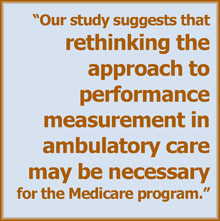Synopsis
Physicians’ quality of care and cost performance can be reliably measured only in practices that treat a sufficient number of patients. As this study shows, the vast majority of primary care physicians work in practices that see too few Medicare patients annually to produce statistically reliable performance assessments. Medicare’s current method of measuring ambulatory care quality may not be effective for most primary care physicians.
 The Issue
The Issue
While health care costs continue to rise, numerous studies have shown that quality of care is flagging. Performance measurements and incentives have been devised as a means to improve quality of care and reduce costs. Many physicians provide a wide variety of services to different patients, making it unlikely that they see a sufficient number of eligible patients to produce statistically reliable performance measurements. This study examined primary care practices to determine if they see enough Medicare patients annually to detect meaningful differences in cost and quality measures, including mammography testing for women 66 to 69 years old and hemoglobin A1c testing for 66-to-75-year-olds with diabetes.
Key Findings
- The caseloads required to reliably detect a 10 percent relative difference on five commonly used performance measures ranged from a minimum of 328 patients (for mammography) to 19,069 patients (for preventable hospitalization).
- The majority of primary care physicians (61%) work in solo practices and see a median of 170 Medicare patients annually. The national median caseload of all Medicare patients treated annually in primary care physician practices was 260 patients.
- Almost no practices with fewer than six primary care physicians had enough patients to reliably detect a 10 percent difference in cost or quality. Approximately 9 percent of practices with six to 10 physicians had enough patients to do so, but fewer than 3 percent could do so with mammography or hemoglobin testing.
- Approximately 50 percent of practices with 11 to 20 physicians had enough patients to reliably detect a 10 percent difference in widely used quality or cost measures, but fewer than 30 percent could do so for any quality measures. More than half of practices with 21 to 50 physicians and all practices with more than 50 physicians had enough patients to detect differences in costs, mammography, and hemoglobin testing.
- No primary care physician practices had sufficient caseloads to detect relative differences for preventable hospitalization or 30-day readmission for discharge after congestive heart failure.
- Nationally, commonly used performance measures could be accurately calculated in less than 2 percent of all primary care physician practices.
Addressing the Problem
Roughly 65 percent of all primary care physicians active in the Medicare program work in practices with insufficient numbers of beneficiaries to reliably detect meaningful differences in cost and quality measures. As such, Medicare should reconsider its performance measurement strategy for evaluating ambulatory care. Options to consider include pooling patients from all payer sources or across measures, measuring performance over a two- or three-year period, or grouping smaller practices into virtual groups or networks—like independent physician associations or physician–hospital associations—of more than 50 physicians.
About the Study
The authors used the Healthcare Organization Services database to link eligible primary care physicians to their practices. They then identified Medicare beneficiaries with office visits to each physician to estimate Medicare caseloads per practice. Finally, they estimated the number of primary care physician practices with sufficient caseloads to detect 10 percent relative differences in the following measures: national mean ambulatory Medicare spending, rates of mammography for women 66 to 69 years old, hemoglobin A1c testing for 66- to 75-year-olds with diabetes, rate of preventable hospitalization, and the 30-day readmission rate after discharge for congestive heart failure. This study was supported by The Commonwealth Fund and the National Institute on Aging.
The Bottom Line
Relatively few primary care physician practices are large enough to reliably measure difference in common quality and cost measures. New measures are needed for assessing performance and generating accountability.


